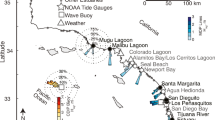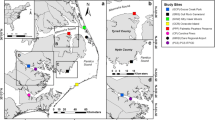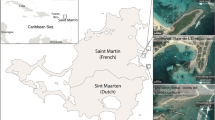Abstract
Coastal marine heatwaves have destructive and lasting impacts on foundational species and are increasing in frequency, duration, and magnitude. High atmospheric temperatures are often associated with marine heatwaves (MHW) which are defined as 5 days of water temperatures above a seasonally varying 90th percentile threshold. In this study, we consider the prevalence of MHW propagation into surficial sediments to cause sediment heatwaves (SHW). Within a shallow, subtidal seagrass meadow in Virginia, USA, sediment temperature was measured at hourly intervals at a depth of 5 cm between June 2020 and October 2022 at the meadow edge and central meadow interior. The observed sediment temperature along with a 29-year record of water temperature and water level was used to develop a sediment temperature model for each location. Modeled sediment temperatures were used to identify sediment heatwaves that may thermally stress belowground seagrass. At both meadow locations, sediment heatwave frequency increased at a rate twice that of MHWs in the average global open ocean, coinciding with a 172% increase in the annual number of SHW days, from 11 to 30 days year−1 between 1994 and 2022. Sediment heatwaves at both meadow locations co-occurred with a MHW 79–81% of the time, with nearly all SHWs having a zero day lag. The top 10% most extreme MHWs and SHWs occurred between November and April when thermal stress to seagrass was unlikely. In June 2015, a SHW co-occurred with an anomalously long duration MHW that was associated with a 90% decline in seagrass from this system, suggesting that SHWs may have contributed to the observed seagrass loss. These results document heatwave propagation across the pelagic-sediment interface which likely occur broadly in shallow systems with impacts to critical coastal ecosystem processes and species dynamics.







Similar content being viewed by others
Data Availability
The high frequency water and sediment temperature time series from South Bay, VA (Tassone and Pace 2023) are publicly available on the Environmental Data Initiative data repository. Wachapreague water temperature and water level are publicly accessible via the NOAA Tides & Currents webpage (tidesandcurrents.noaa.gov/stationhome.html?id=8631044). Code used to run all analyses and produce all figures (except for the map in Fig. 1) are archived on GitHub and available at https://github.com/spencertassone/SedimentHeatwaves.
References
Aoki, L.R., K.J. McGlathery, P.L. Wiberg, M.P.J. Oreska, A.C. Berger, P. Berg, and R.J. Orth. 2021. Seagrass recovery following marine heat wave influences sediment carbon stocks. Frontiers in Marine Science 7: 576784. https://doi.org/10.3389/fmars.2020.576784.
Arias-Ortiz, A., O. Serrano, P. Masqué, P.S. Lavery, U. Mueller, G.A. Kendrick, M. Rozaimi, A. Esteban, J.W. Fourqurean, N. Marbà, M.A. Mateo, K. Murray, M.J. Rule, and C.M. Duarte. 2018. A marine heatwave drives massive losses from the world’s largest seagrass carbon stocks. Nature Climate Change 8 (4): 338–344. https://doi.org/10.1038/s41558-018-0096-y.
Berger, A.C. 2021. Long-term aquatic eddy-covariance measurements of seagrass metabolism and ecosystem response to warming ocean. University of Virginia, Environmental Sciences - Graduate School of Arts and Sciences. https://doi.org/10.18130/wfh0-1f94. Ph.D. Dissertation.
Berger, A.C., P. Berg, K.J. McGlathery, and M.L. Delgard. 2020. Long-term trends and resilience of seagrass metabolism: A decadal aquatic eddy covariance study. Limnology and Oceanography 65 (7): 1423–1438. https://doi.org/10.1002/lno.11397.
Collier, C.J., and M. Waycott. 2014. Temperature extremes reduce seagrass growth and induce mortality. Marine Pollution Bulletin 83 (2): 483–490.
Deldicq, N., D. Langlet, C. Delaeter, G. Beaugrand, L. Seuront, and V.M. Bouchet. 2021. Effects of temperature on the behavior and metabolism of an intertidal foraminifera and consequences for benthic ecosystem functioning. Scientific Reports 11 (1): 4013.
Dooley, F.D., S. Wyllie-Echeverria, M.B. Roth, and P.D. Ward. 2013. Tolerance and response of Zostera marina seedlings to hydrogen sulfide. Aquatic Botany 105: 7–10.
Duarte, C.M., J.J. Middelburg, and N. Caraco. 2005. Major role of marine vegetation on the oceanic carbon cycle. Biogeosciences 2 (1): 1–8.
Fourqurean, J.W., C.M. Duarte, H. Kennedy, N. Marbà, M. Holmer, M.A. Mateo, E.T. Apostolaki, G.A. Kendrick, D. Krause-Jensen, K.J. McGlathery, and O. Serrano. 2012. Seagrass ecosystems as a globally significant carbon stock. Nature Geoscience 5 (7): 505–509. https://doi.org/10.1038/ngeo1477.
Frölicher, T.L., E.M. Fischer, and N. Gruber. 2018. Marine heatwaves under global warming. Nature 560 (7718): 360–364.
Glandon, H.L., K.H. Kilbourne, and T.J. Miller. 2019. Winter is (not) coming: Warming temperatures will affect the overwinter behavior and survival of blue crab. PLoS ONE 14 (7): e0219555.
Goodman, J.L., K.A. Moore, and W.C. Dennison. 1995. Photosynthetic responses of eelgrass (Zostera marina L.) to light and sediment sulfide in a shallow barrier island lagoon. Aquatic Botany 50 (1): 37–47.
Gouhier, T.C., A. Grinsted, and V. Simko. 2021. R package {biwavelet}: Conduct univariate and bivariate wavelet analyses (Version 0.20.21). https://github.com/tgouhier/biwavelet.
Groleger, N., J. Morreale, and J.H. Porter. 2022. Gap-filled meteorological data for the Virginia Coast Reserve LTER - 1989-2022. Virginia Coast Reserve Long-Term Ecological Research Project Data Publication knb-lter-vcr.337.2 https://doi.org/10.6073/pasta/4cf8f0db83783b71f7ee001d794e0016.
Hansen, J., and M. Reidenbach. 2012. Wave and tidally driven flows in eelgrass beds and their effect on sediment suspension. Marine Ecology Progress Series 448: 271–287. https://doi.org/10.3354/meps09225.
Hansen, J.C.R., and M.A. Reidenbach. 2013. Seasonal growth and senescence of a Zostera marina seagrass meadow alters wave-dominated flow and sediment suspension within a Coastal Bay. Estuaries and Coasts 36 (6): 1099–1114. https://doi.org/10.1007/s12237-013-9620-5.
Hobday, A., E. Oliver, A. Sen Gupta, J. Benthuysen, M. Burrows, M. Donat, N. Holbrook, P. Moore, M. Thomsen, T. Wernberg, and D. Smale. 2018. Categorizing and naming marine heatwaves. Oceanography 31(2). https://doi.org/10.5670/oceanog.2018.205.
Hobday, A.J., L.V. Alexander, S.E. Perkins, D.A. Smale, S.C. Straub, E.C.J. Oliver, J.A. Benthuysen, M.T. Burrows, M.G. Donat, M. Feng, N.J. Holbrook, P.J. Moore, H.A. Scannell, A. Sen Gupta, and T. Wernberg. 2016. A hierarchical approach to defining marine heatwaves. Progress in Oceanography 141: 227–238. https://doi.org/10.1016/j.pocean.2015.12.014.
Höffle, H., M.S. Thomsen, and M. Holmer. 2011. High mortality of Zostera marina under high temperature regimes but minor effects of the invasive macroalgae Gracilaria vermiculophylla. Estuarine, Coastal and Shelf Science 92 (1): 35–46.
Holbrook, N.J., H.A. Scannell, A. Sen Gupta, J.A. Benthuysen, M. Feng, E.C. Oliver, L.V. Alexander, M.T. Burrows, M.G. Donat, A.J. Hobday, and P.J. Moore. 2019. A global assessment of marine heatwaves and their drivers. Nature Communications 10 (1): 1–13. https://doi.org/10.1038/s41467-019-10206-z.
Jassby, A.D., and J.E. Cloern. 2017. wq: some tools for exploring water quality monitoring data. R package version 0.4.9 https://cran.r-project.org/package=wq.
Joint, I., and D.A. Smale. 2017. Marine heatwaves and optimal temperatures for microbial assemblage activity. FEMS Microbiology Ecology 93 (2): fiw243. https://doi.org/10.1093/femsec/fiw243.
Kauppi, L., and A. Villnäs. 2022. Marine heatwaves of differing intensities lead to distinct patterns in seafloor functioning. Proceedings of the Royal Society B 289: 20221159. https://doi.org/10.1098/rspb.2022.1159.
Krumhansl, K.A., M. Dowd, and M.C. Wong. 2021. Multiple metrics of temperature, light, and water motion drive gradients in eelgrass productivity and resilience. Frontiers in Marine Science 8: 597707. https://doi.org/10.3389/fmars.2021.597707.
Lamb, J.B., J.A.J.M. van de Water, D.G. Bourne, C. Altier, M.Y. Hein, E.A. Fiorenza, N. Abu, J. Jompa, and C.D. Harvell. 2017. Seagrass ecosystems reduce exposure to bacterial pathogens of humans, fishes, and invertebrates. Science 355 (6326): 731–733. https://doi.org/10.1126/science.aal1956.
Lima, F.P., and D.S. Wethey. 2012. Three decades of high-resolution coastal sea surface temperatures reveal more than warming. Nature Communications 3 (1): 704. https://doi.org/10.1038/ncomms1713.
Macreadie, P.I., A. Anton, J.A. Raven, N. Beaumont, R.M. Connolly, D.A. Friess, J.J. Kelleway, H. Kennedy, T. Kuwae, P.S. Lavery, C.E. Lovelock, D.A. Smale, E.T. Apostolaki, T.B. Atwood, J. Baldock, T.S. Bianchi, G.L. Chmura, B.D. Eyre, J.W. Fourqurean, and C.M. Duarte. 2019. The future of blue carbon science. Nature Communications 10 (1): 3998. https://doi.org/10.1038/s41467-019-11693-w.
McGlathery, K., L. Reynolds, L. Cole, R. Orth, S. Marion, and A. Schwarzschild. 2012. Recovery trajectories during state change from bare sediment to eelgrass dominance. Marine Ecology Progress Series 448: 209–221. https://doi.org/10.3354/meps09574.
McLeod, A.I. 2011. Kendall: Kendall rank correlation and Mann-Kendall trend test. R package version 2.2. https://CRAN.R-project.org/package=Kendall.
Meehl, G.A., and C. Tebaldi. 2004. More intense, more frequent, and longer lasting heat waves in the 21st Century. Science 305 (5686): 994–997. https://doi.org/10.1126/science.1098704.
Nahlik, A.M., and M.S. Fennessy. 2016. Carbon storage in US wetlands. Nature Communications 7 (1): 1–9.
Oliver, E.C.J., J.A. Benthuysen, S. Darmaraki, M.G. Donat, A.J. Hobday, N.J. Holbrook, R.W. Schlegel, and A. Sen Gupta. 2021. Marine heatwaves. Annual Review of Marine Science 13 (1): 313–342. https://doi.org/10.1146/annurev-marine-032720-095144.
Oliver, E.C.J., M.G. Donat, M.T. Burrows, P.J. Moore, D.A. Smale, L.V. Alexander, J.A. Benthuysen, M. Feng, A. Sen Gupta, A.J. Hobday, N.J. Holbrook, S.E. Perkins-Kirkpatrick, H.A. Scannell, S.C. Straub, and T. Wernberg. 2018. Longer and more frequent marine heatwaves over the past century. Nature Communications 9 (1): 1324. https://doi.org/10.1038/s41467-018-03732-9.
Oreska, M.P.J., K.J. McGlathery, and J.H. Porter. 2017. Seagrass blue carbon spatial patterns at the meadow-scale. PLoS ONE 12 (4): e0176630. https://doi.org/10.1371/journal.pone.0176630.
Oreska, M.P.J., K.J. McGlathery, L.R. Aoki, A.C. Berger, P. Berg, and L. Mullins. 2020. The greenhouse gas offset potential from seagrass restoration. Scientific Reports 10 (1): 7325. https://doi.org/10.1038/s41598-020-64094-1.
Orth, R.J., J.S. Lefcheck, K.S. McGlathery, L. Aoki, M.W. Luckenbach, K.A. Moore, P.J. Oreska, R. Snyder, D.J. Wilcox, and B. Lusk. 2020. Restoration of seagrass habitat leads to rapid recovery of coastal ecosystem services. Science Advances 6 (41): eabc6434. https://doi.org/10.1126/sciadv.abc6434.
Ouellette, D., G. Desrosiers, J.P. Gagne, F. Gilbert, J.C. Poggiale, P.U. Blier, and G. Stora. 2004. Effects of temperature on in vitro sediment reworking processes by a gallery biodiffusor, the polychaete Neanthes virens. Marine Ecology Progress Series 266: 185–193. https://doi.org/10.3354/meps266185.
Pedersen, O., T. Binzer, and J. Borum. 2004. Sulphide intrusion in eelgrass (Zostera marina L.). Plant, Cell and Environment 27 (5): 595–602. https://doi.org/10.1111/j.1365-3040.2004.01173.x.
Perkins, S.E., and L.V. Alexander. 2013. On the measurement of heat waves. Journal of Climate 26 (13): 4500–4517. https://doi.org/10.1175/JCLI-D-12-00383.1.
Pohlert, T. 2020. Trend: non-parametric trend tests and change-point detection. R package version 1.1.4. https://CRAN.R-project.org/package=trend.
R Core Team. 2022. R: A language and environment for statistical computing. R Foundation for Statistical Computing, Vienna, Austria. https://www.R-project.org/.
Román, M., F. Gilbert, R.M. Viejo, S. Román, J.S. Troncoso, E. Vázquez, and C. Olabarria. 2023. Are clam-seagrass interactions affected by heatwaves during emersion? Marine Environmental Research 186: 105906.
Safak, I., P.L. Wiberg, D.L. Richardson, and M.O. Kurum. 2015. Controls on residence time and exchange in a system of shallow coastal bays. Continental Shelf Research 97: 7–20. https://doi.org/10.1016/j.csr.2015.01.009.
Schlegel, R.W., E.C.J. Oliver, S. Perkins-Kirkpatrick, A. Kruger, and A.J. Smit. 2017a. Predominant atmospheric and oceanic patterns during coastal marine heatwaves. Frontiers in Marine Science 4: 323. https://doi.org/10.3389/fmars.2017.00323.
Schlegel, R.W., E.C.J. Oliver, T. Wernberg, and A.J. Smit. 2017b. Nearshore and offshore co-occurrence of marine heatwaves and cold-spells. Progress in Oceanography 151: 189–205. https://doi.org/10.1016/j.pocean.2017.01.004.
Schlegel, R.W., and A.J. Smit. 2018. HeatwaveR: a central algorithm for the detection of heatwaves and cold-spells. Journal of Open Source Software 3 (27): 821. https://doi.org/10.21105/joss.00821.
Serrano, O., A. Arias-Ortiz, C.M. Duarte, G.A. Kendrick, and P.S. Lavery. 2021. Impact of marine heatwaves on seagrass ecosystems. In Ecosystem Collapse and Climate Change, vol. 241, ed. J.G. Canadell and R.B. Jackson. Ecological Studies. Cham: Springer. https://doi.org/10.1007/978-3-030-71330-0_13.
Strydom, S., K. Murray, S. Wilson, B. Huntley, M. Rule, M. Heithaus, C. Bessey, G.A. Kendrick, D. Burkholder, M.W. Fraser, and K. Zdunic. 2020. Too hot to handle: Unprecedented seagrass death driven by marine heatwave in a World Heritage Area. Global Change Biology 26 (6): 3525–3538. https://doi.org/10.1111/gcb.15065.
Tassone, S.J. 2023. Quantifying heatwaves and seagrass recovery dynamics in aquatic ecosystems. University of Virginia, Environmental Sciences - Graduate School of Arts and Sciences, Ph.D. Dissertation. https://doi.org/10.18130/0vkc-jj16.
Tassone, S.J., and M.L. Pace. 2023. High-frequency water and sediment temperature from the seagrass recovery experiment, South Bay, VA 2020–2022 ver 1. Environmental Data Initiative. https://doi.org/10.6073/pasta/9d0556bf46a3a79b6bde96003529f407 .
Tassone, S.J., A.F. Besterman, C.D. Buelo, J.A. Walter, and M.L. Pace. 2022b. Co-occurrence of aquatic heatwaves with atmospheric heatwaves, low dissolved oxygen, and low pH events in estuarine ecosystems. Estuaries and Coasts 45 (3): 707–720. https://doi.org/10.1007/s12237-021-01009-x.
Tassone, S.J., A.F. Besterman, C.D. Buelo, D.T. Ha, J.A. Walter, and M.L. Pace. 2022a. Increasing heatwave frequency in streams and rivers of the United States. Limnology and Oceanography Letters lol2.10284. https://doi.org/10.1002/lol2.10284.
Thoral, F., S. Montie, M.S. Thomsen, L.W. Tait, M.H. Pinkerton, and D.R. Schiel. 2022. Unravelling seasonal trends in coastal marine heatwave metrics across global biogeographical realms. Scientific Reports 12 (1): 7740. https://doi.org/10.1038/s41598-022-11908-z.
Unsworth, R.K.F., C.J. Collier, M. Waycott, L.J. Mckenzie, and L.C. Cullen-Unsworth. 2015. A framework for the resilience of seagrass ecosystems. Marine Pollution Bulletin 100 (1): 34–46. https://doi.org/10.1016/j.marpolbul.2015.08.016.
Wiberg, P.L. 2023. Temperature amplification and marine heatwave alteration in shallow coastal bays. Frontiers in Marine Science, 10. https://doi.org/10.3389/fmars.2023.1129295.
Wuebbles, D.J., D.W. Fahey, K.A. Hibbard, B. DeAngelo, S. Doherty, K. Hayhoe, R. Horton, J.P. Kossin, P.C. Taylor, A.M. Waple, and C.P. Yohe. 2017. Executive summary. Climate Science Special Report: Fourth National Climate Assessment, Volume I. U.S. Global Change Research Program. https://doi.org/10.7930/J0DJ5CTG.
Acknowledgements
We thank Patricia L. Wiberg, Karen J. McGlathery, and Julianne Quinn for helpful discussions and early revisions to this manuscript, and Jonathan A. Walter for assistance with the wavelet analysis. We thank the staff of the LTER-Virginia Coast Reserve (Cora Baird, Amelie Berger, Tom Burkett, Buck Doughty, Donna Fauber, Sophia Hoffman, David Lee, and Jonah Morreale) for field assistance.
Funding
This work was supported by funding from an NSF grant supporting the LTER-Virginia Coast Reserve (DEB 1832221) and the Jefferson Scholars Foundation.
Author information
Authors and Affiliations
Corresponding author
Additional information
Communicated by Nathan Waltham
Supplementary Information
Below is the link to the electronic supplementary material.
Rights and permissions
Springer Nature or its licensor (e.g. a society or other partner) holds exclusive rights to this article under a publishing agreement with the author(s) or other rightsholder(s); author self-archiving of the accepted manuscript version of this article is solely governed by the terms of such publishing agreement and applicable law.
About this article
Cite this article
Tassone, S.J., Pace, M.L. Increased Frequency of Sediment Heatwaves in a Virginia Seagrass Meadow. Estuaries and Coasts 47, 656–669 (2024). https://doi.org/10.1007/s12237-023-01314-7
Received:
Revised:
Accepted:
Published:
Issue Date:
DOI: https://doi.org/10.1007/s12237-023-01314-7




